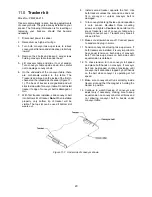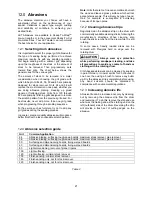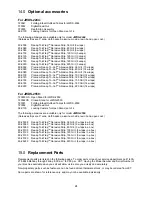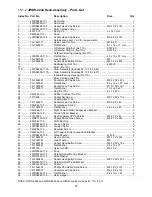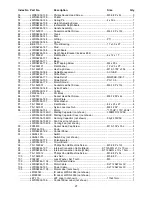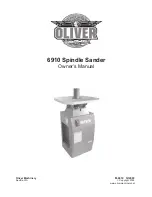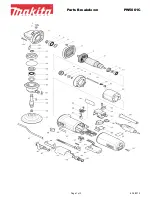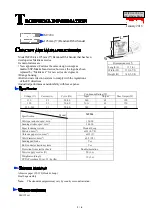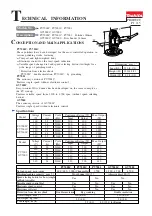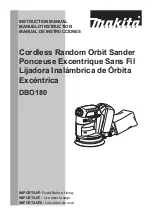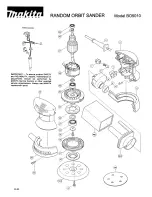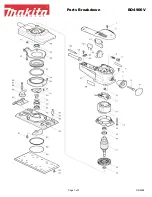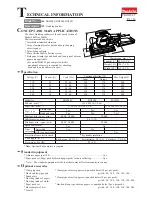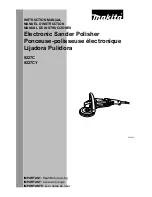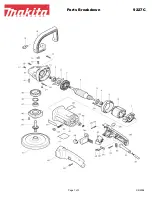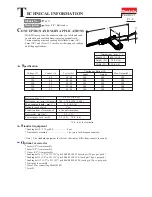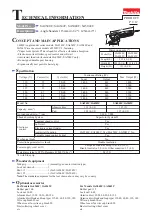
16
9.0
Operations
Before using the drum sander, review the previous
sections on initial set-up and adjustment. Before
operating, make sure an abrasive strip is mounted
and a proper dust collection system is connected.
9.1
Basic Operating Procedure
1. Establish depth of cut.
2. Start dust collection system.
3. Start sanding drum.
4. Start conveyor and select feed rate.
5. Feed stock through machine.
To feed stock through the sander, rest and hold
board to be sanded on conveyor belt, allowing
conveyor belt to carry board into drum. Once stock
is halfway through, reposition yourself to outfeed
side of machine to receive and control board as it
exits.
Board will be forced down
against conveyor table as it begins feeding,
causing pinching hazard. Keep fingers away.
Do not open drum hood until
drum comes to a complete stop.
9.2
Switch safety key
To prevent unauthorized use of sander, turn off
switch and pull out safety key (Figure 9-1). Store key
in a safe place. Key must be reinserted to start
sander.
Figure 9-1: safety key
9.3
Setting depth of cut
Adjusting the drum sander for proper contact
between abrasive and stock determines the depth
of cut, which is controlled by the height adjustment
handle.
It may take experimentation to determine proper
depth of cut, given the variables of abrasive grit,
type of wood, and feed rate. For best results, use
scrap wood to practice sanding and to develop skill
and familiarity with the machine before doing finish
work.
A combination of several variables will determine
proper depth of cut to use, including the following:
1. Abrasive type and grit size.
2. Width of piece being processed.
3. Hardness of piece.
4. Feed rate of conveyor belt.
NOTE:
The use of a carrier or backer board (not
provided), is recommended for cuts 1/16” or less.
This is a flat board, usually of wood or MDF, slightly
larger than the workpiece and of even thickness,
placed beneath the workpiece as it is fed through
the sander. The workpiece may be attached to the
carrier with rubber cement, carpenter’s tape or
some other easily removable adhesive. However,
some operators use a rubber or textured surface on
the carrier to help stabilize the workpiece by simple
friction.
9.4
Establishing drum height
A good rule of thumb when sanding with grits finer
than 80:
1. To establish drum height, position stock under
the drum. Do NOT start drum.
2. Lower drum to the stock thickness, making sure
drum can still be rotated by hand while just
contacting stock.
Do not start drum while in
contact with stock.
3. Without changing drum height, turn on
conveyor and run the stock out from under the
drum. Start sanding drum and sand stock at that
same position.
4. With the drum operating, feed stock under the
drum from the infeed side and against the
rotation of the drum. Always maintain control of
the stock to avoid kickback and/or slippage.
NOTE: If motor heats up during operation,
depth of cut may be too great for size of grit
and/or feed rate may be too fast.
For sanding with grits coarser than 80, you can
lower the drum slightly.
Always maintain control of stock. Through practice
you will learn the proper depth of cut considering the
variables above.
9.5
Selecting SandSmart™ feed rates
A faster feed rate allows faster sanding but fewer
revolutions of the drum per inch of sanding. A slower
feed rate provides more revolutions of the drum per
inch of sanding to allow a greater depth of cut and
smooth sanding.
Begin experimenting with the feed rate set at about
40% to 50% of maximum. The best feed rate will



















